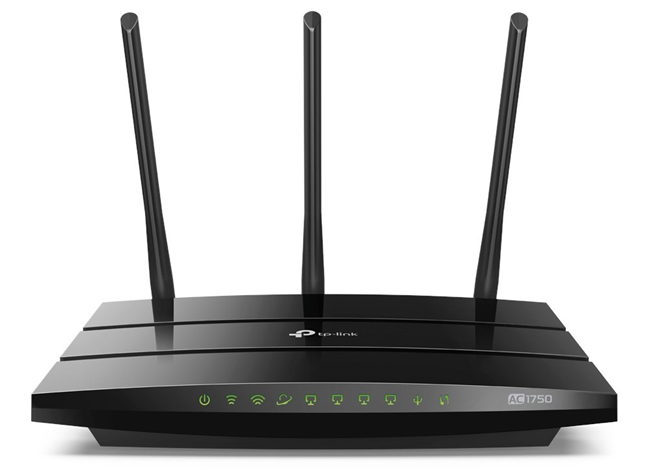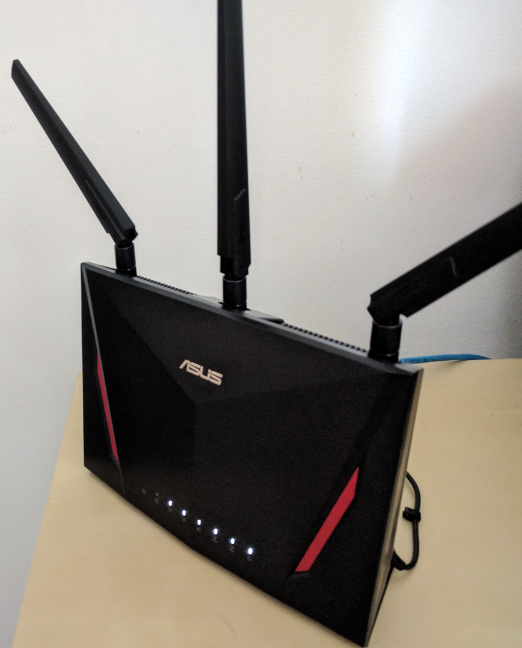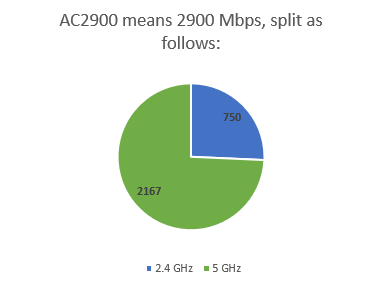
All wireless routers have AC in their name, followed by a number. For example, you have routers that are called: Tenda AC9 AC1200, TP-Link Archer C7 AC1750, NETGEAR Nighthawk XR500 AC2500, or ASUS RT-AC88U AC3100. What does this AC followed by a number mean? Does the number following AC tell you how fast the router is? Is an AC1900 router faster than an AC1200 router? In theory, manufacturers say that it is. In reality, the truth is different. Here is why this AC naming convention is marketing with little value for consumers, and how not to fool yourself when purchasing a wireless router:
What does AC1200, AC1750, AC1900, AC2900, AC3200, and other similar naming means, when it comes to routers?
When you purchase a wireless router, you see the term AC followed by a number, somewhere in its name. Newer models may have the terms AX followed by an even larger number. AC means that the router has support for the 802.11ac (or Wi-Fi 5) wireless networking standard, which offers fast WiFi network connections on the 5GHz frequency. AX means that the router has support for the 802.11ax (or Wi-Fi 6) wireless networking standard.
The number that comes after AC or AX represents the maximum THEORETICAL bandwidth of the router. 1200 means 1200 Mbps, 1900 means 1900 Mbps, 3200 means 3200 Mbps, and so on. When reading AC2300 in the name of a router, it means that you are dealing with a WiFi router that offers a wireless network using the 802.11ac (Wi-Fi 5) standard, with a total maximum theoretical bandwidth of 2300 Mbps.
You might be tempted to believe that an AC3200 router provides a wireless network that works at 3200 Mbps. That would be amazing, but, unfortunately, it is false. The truth is that this naming convention is not useful for making a purchasing decision. It is just a marketing tactic that tries to make you believe that a router is faster than it really is.
AC1200, AC1750, AC1900 and so on, is a sum of all the bands on which the router emits WiFi signal, not the real speed of the router
One key aspect of the calculation that results in an AC or AX naming is the number of bands or frequencies on which the router emits the wireless signal. Let's take a modern and popular router as an example: ASUS RT-AC86U AC2900.
This router has two bands, each of them with its own maximum theoretical bandwidth:
- The first band (and the slowest) is the 2.4 GHz wireless band. It has a maximum theoretical bandwidth of 750 Mbps.
- The second band (and the fastest) is the 5 GHz wireless band. It has a maximum theoretical bandwidth of 2167 Mbps.
Therefore, AC2900 is not the maximum bandwidth you get on one wireless band or frequency, but the sum of all the available wireless bands or frequencies. The maximum speed you could get is that of the fastest band - 2167 Mbps on the 5 GHz wireless band - only in laboratory conditions, which we are going to explain later in this article.
To give you an even better understanding, here's how wireless routers are categorized when it comes to bands or frequencies:
- Single-band and emit WiFi only on one wireless frequency, meaning that they emit only one wireless network. In most cases, they emit on the 2.4 GHz frequency, and they have up to AC1000 in their name. Some manufacturers have stopped producing such routers. They have incredibly low prices, but are not the right choice for modern smart homes, because they are underpowered, and use an old wireless networking standard that is not suitable for Full HD movie streaming, online gaming, and so on.
- Dual-band and emit WiFi on two wireless frequencies: 2.4 GHz (which is slower but with a larger coverage area) and 5 GHz (which is faster but with a smaller coverage area). You see two wireless networks being broadcast, with different names. You can also change the settings for both bands to use the same network name. The majority of modern routers are dual-band. Their pricing varies a lot, but it tends to be accessible for most people. However, one observation is that the lower the number after the AC naming convention, the lower the price. Therefore, an AC1750 wireless router should be cheaper than an AC2900 wireless router.
- Tri-band and emit on three wireless frequencies: one 2.4 GHz frequency and two 5 GHz frequencies. You see three wireless networks being broadcast, but they can be set to use the same name. The most expensive wireless routers are tri-band, and their names have AC3200 or more in their name. Some of the latest routers even have AC5400 in their name, making you believe that they emit wireless networks at 5400 Mbps, which is far from the truth.
To make sure that you understand the number of bands and how they are related to the AC naming convention, let's take one final example: TP-Link Archer C5400X. It is an AC5400 wireless router with three bands, having their maximum theoretical bandwidth split like in the graphic below:
- 1000 Mbps for the 2.4 GHz wireless band
- 2167 Mbps for each of the two 5 GHz wireless bands
The maximum speed you could get from this router, on WiFi, is 2167 Mbps on each of its two 5 GHz wireless bands, in laboratory conditions.
Why is the AC naming convention misleading?
The AC naming convention used by wireless router manufacturers is misleading, because it sums up the maximum theoretical bandwidth of all the wireless bands that are broadcast by the wireless router. That's how we end-up with crazy numbers like AC5400. In reality, you do not get 5400 Mbps on WiFi, when using an AC5400 wireless router, because network devices can connect to only one band at a time, not all bands at once. To better understand, look at the picture below. There are three network devices (an iPhone, a Surface Pro, and an Xbox One), each connected to a different WiFi band, from the three made available by the TP-Link Archer C5400X router.
The speed these devices get is never bigger than the theoretical maximum bandwidth of the wireless band that they are connected to. Therefore, the iPhone won't get a speed that is higher than 1000 Mbps, while the other two devices won't get a speed that is higher than 2167 Mbps.
How is the maximum wireless bandwidth measured in manufacturer's labs?
Earlier we gave an example of a tri-band router and explained that a naming like AC5400 did not mean that it offers a wireless network at 5400 Mbps. You could assume that the top speed you get on WiFi is 2167 Mbps - the maximum theoretical bandwidth for the two 5 GHz bands offered by the router. Unfortunately, this is also false. This is because ALL manufacturers of networking equipment such as WiFi routers, do not use real-life measuring environments, like people's homes and apartments. They do their measurements in specialized labs so that they can claim the maximum possible speed. Here is what router manufacturers tend to do, to calculate the total maximum bandwidth:
- The measurements are made in labs without thick walls that absorb the wireless signal, and with a direct line of sight between the router and the network clients used to make the calculations.
- They place the devices that they use for measuring the bandwidth at an optimal distance of two to three meters (6 to 10 feet). They have no interest in measuring the bandwidth in the far corner of a home or apartment, or in a room separated from the router by a thick wall.
- Many times, they use two or three identical routers connected to each other to measure the maximum bandwidth when transferring data between them. Companies do not use regular computers or smartphones, like users do, because their routers have better support for wireless technologies than the network cards included in PCs, laptops, tablets or smartphones. As a result, their transfers are faster than when using a laptop, for example.
- When manufacturers use computers for measuring the maximum bandwidth, they use expensive high-end PCs, with the best possible processor, RAM, and the fastest network card for the network standards that they are using on their routers. Most users do not have the same budget to invest in similar high-end computers. Would you buy a high-end wireless network card like ASUS PCE-AC88? Most people would not.
- Networking companies measure the wireless bandwidth using specialized networking software and drivers, that are optimized to work with the latest standards and WiFi technologies. Many computers and devices often use older software and operating systems, that do not work as well with modern WiFi networking technologies. Often, drivers are also outdated, especially those of the network cards on most consumer laptops.
- Manufacturers connect the smallest possible number of devices to the WiFi broadcast by their routers, so that they measure its maximum bandwidth. In your home or workplace, you connect a lot more devices than they do, at the same time, causing them to fight over the available wireless bandwidth.
- They place the router's antennas in a position that guarantees the maximum wireless throughput. In your home, you are likely to place the router and its antennas in a less optimal way, to make sure the router is not in your way or easily reached by children.
- Companies optimize their firmware settings for maximum speed. For example, on some WiFi routers, the USB port, depending on its positioning and default settings, can lower the maximum wireless throughput. Therefore, networking companies change the firmware settings to lower the USB throughput and minimize interference, while measuring the wireless bandwidth. They may also disable security features that reduce the WiFi speed, like real-time antivirus scanning or parental controls.
How big is the difference between AC naming conventions and reality?
The differences between AC naming conventions and the speeds you get in real life can be depressingly high. They also vary wildly, and, many times, routers with high numbers in their AC naming are not necessarily faster than others with lower numbers. To give you a better perspective, let's discuss some examples:
An affordable AC1200 router like Tenda AC9, delivers a maximum download speed of 224.09 Mbps, on the 5 GHz band, when using a regular Windows 10 laptop. Its theoretical maximum bandwidth for that band is of 867 Mbps. The real-life speed you get is 2.86 times lower than its advertised maximum bandwidth.
An AC1900 wireless router like Linksys EA7500 v2 has a maximum theoretical bandwidth of 1300 Mbps for the 5 GHz band. When you use a normal Windows 10 laptop, you get a maximum download speed of 539.86 Mbps. The real-life speed you get is 2.4 times lower than its advertised maximum bandwidth.
Next, let's look at an AC2900 wireless router, like ASUS ROG Rapture GT-AC2900, with a theoretical maximum bandwidth of 2167 Mbps for the 5 GHz band. In real life, you can reach 701.60 Mbps for the download speed, only in the room where the router is placed, using an expensive network card like ASUS PCE-AC88. That's three times lower than its advertised maximum bandwidth.
Getting back to an AC1900 router, like ASUS Blue Cave. With the same expensive network card, it obtained an even higher download speed: 741.54 Mbps. The fun bit is that this router has a maximum theoretical bandwidth of 1734 Mbps for the 5 GHz band, which is lower than that of the more expensive AC2900 wireless router. Even so, the real-life speed is 2.33 lower than its advertised maximum bandwidth.
All this data proves that the AC naming conventions used for wireless routers are unrealistic estimations, that should not matter when you choose your next router. Other criteria are a lot more important: 8 things to consider when buying a wireless router (for beginners)
If you want to know the real-life speed you get from a wireless router, before purchasing it, you should read in-depth reviews online. Many websites, like Digital Citizen, spend a lot of time testing wireless routers and showing what you get in normal, day-to-day situations, without expensive lab equipment.
How should I interpret this AC naming convention, when it comes to wireless routers?
The AC naming convention does not tell you the real-life speed of the wireless network that you get when buying one router or another. This naming convention tells you other things like:
- Whether the router is expensive or affordable. Wireless routers up to AC1750 and sometimes even AC1900, tend to be affordable for most people. Routers above AC3200 are always premium models for which you pay a lot of money.
- Whether the router is single band, dual-band or tri-band: routers up to AC1000 are always single band, and emit their WiFi signal on the slow 2.4 GHz frequency. AC1200 routers up to AC3200 are dual-band routers that emit their signal both on the 2.4 GHz and 5 GHz frequencies. Routers with a naming convention above AC3200 are tri-band wireless routers.
- The features you get: routers up to AC1750 tend to be affordable, and they only have the basic features people need. Routers above that tend to offer more and more advanced features, like included antivirus protection, advanced parental controls, or gaming-oriented services.
- How powerful their hardware is: routers up to AC1750 have single-core processors, with limited hardware resources. When you go up to AC3200, you get dual-core processors and more RAM and storage space on your router. Going close to AC5400, you get quad-core processors and lots of RAM. One rule to remember is that the better the hardware of your router, the more network clients it can serve, with better quality and speed.
To summarize our conclusions, we created the illustration below, to help you remember how the AC naming convention is used.
Are there any other questions left unanswered?
We at Digital Citizen have tested many wireless routers from many manufacturers: ASUS, TP-Link, Netgear, Tenda, D-Link, Linksys, Synology, and others. This article was made based on years of working in this field. We hope that we clarified the realities of this industry and that you now know a lot more about this naming convention and how it is used. If you have any questions left unanswered, comment below and let's discuss.


 25.06.2019
25.06.2019 












